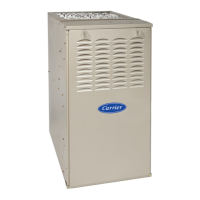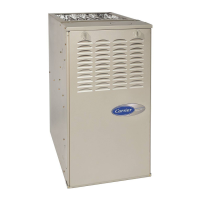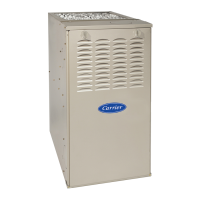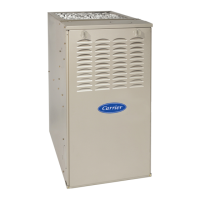26
VENTING NOTES FOR FIGURES 26 − 31
1. For common vent, vent connector sizing and vent material: United States−−use the NFGC.
2. Immediately increase to 5−inch (127 mm) or 6−inch (152 mm) vent connector outside furnace casing when 5−inch (127 mm) vent connector is required, refer to Note 1
above.
3. Side outlet vent for upflow and downflow installations must use Type B vent immediately after exiting the furnace, except when factory−authorized, Downflow Vent
Guard Kit, is used in the downflow position. See Product Data Sheet for accessory listing.
4. Type−B vent where required, refer to Note 1 above.
5. Four−inch single−wall (26 ga. min.) vent must be used inside furnace casing and when the Downflow Vent Guard Kit is used external to the furnace. See Product Data
Sheet for accessory listing.
6. Factory−authorized accessory Downflow Vent Guard Kit required in downflow installations with lower vent configuration. See Product Data Sheet for accessory listing.
7. Secure vent connector to furnace elbow with (2) corrosion−resistant sheet metal screws, spaced approximately 180_ apart.
8. Secure all other single wall vent connector joints with (3) corrosion resistant screws spaced approximately 120_ apart. Secure Type−B vent connectors per vent connector
manufacturer ’s recommendations.
START−UP, ADJUSTMENT, AND SAFETY
CHECK
General
FIRE HAZARD
Failure to follow this warning could result in personal
injury, death and/or property damage.
This furnace is equipped with manual reset limit switches in
the gas control area. The switches open and shut off power
to the gas valve if a flame rollout or overheating condition
occurs in the gas control area. DO NOT bypass the
switches. Correct inadequate combustion air supply
problem before resetting the switches.
!
WARNING
CUT HAZARD
Failure to follow this caution may result in personal injury.
Sheet metal parts may have sharp edges or burrs. Use care
and wear appropriate protective clothing, safety glasses and
gloves when handling parts and servicing furnaces.
CAUTION
!
1. Maintain 115−v wiring and ground. Improper polarity will
result in rapid flashing LED and no furnace operation.
2. Make thermostat wire connections at the 24−v terminal
block on the furnace control. Failure to make proper con-
nections will result in improper operation. (See Fig. 24)
3. Gas supply pressure to the furnace must be greater than
4.5−In. W.C. (0.16 psig ) but not exceed 14−In. W.C. (0.5
psig).
4. Check all manual−reset switches for continuity.
5. Install blower compartment door. Door must be in place to
operate furnace.
6. Replace outer door.
Start−Up Procedures
FIRE AND EXPLOSION HAZARD
Failure to follow this warning could cause personal injury,
death and/or property damage.
Never test for gas leaks with an open flame. Use a
commercially available soap solution made specifically for
the detection of leaks to check all connections. A fire or
explosion may result causing property damage, personal
injury or loss of life.
!
WARNING
1. Purge gas lines after all connections have been made.
2. Check gas lines for leaks.
3. Verify furnace shut down by lowering thermostat setting
below room temperature.
4. Verify furnace restarts by raising thermostat setting above
room temperature.
Adjustments
FIRE HAZARD
Failure to follow this warning could result in injury, death
and/or property damage.
DO NOT bottom out gas valve regulator adjusting screw.
This can result in unregulated gas valve outlet pressure and
result in excess overfire and heat exchanger failures.
!
WARNING
FURNACE DAMAGE HAZARD
Failure to follow this caution may result in reduced furnace
life.
DO NOT redrill orifices. Improper drilling (burrs,
out−of−round holes, etc.) can cause excessive burner noise
and misdirection of inlet gas. (See Fig. 33)
CAUTION
!
Furnace gas input rate on rating plate is for installations at
altitudes up to 2000 ft. (610 M). Furnace input rate must be
within +/−2 percent of furnace rating plate input.
1. Determine the correct gas input rate. Refer to the unit
rating plate
2. Determine the correct outlet gas pressure adjustment.
a. Obtain average yearly gas heat value (at installed altitude)
from local gas supplier.
b. Obtain average yearly gas specific gravity from local gas
supplier.
c. Find closest natural gas heat value and specific gravity
in Tables 11 or 12.
d. Follow heat value and specific gravity lines to point of
intersection to find outlet pressure setting for proper
operation.
3. Check Inlet Gas Pressure
The inlet gas pressure must be checked with the furnace
operating. This is necessary to make sure the inlet gas pressure
does not fall below the minimum pressure of 4.5 in. w.c.
a. Make sure the gas supply is turned off to the furnace and
at the electric switch on the gas valve

